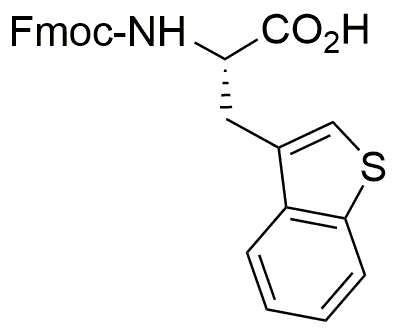Fmoc-3-(3-benzothienyl)-L-alanine is widely utilized in research focused on:
- Peptide Synthesis: This compound serves as a key building block in the synthesis of peptides, especially in solid-phase peptide synthesis, allowing researchers to create complex and functional peptide sequences efficiently.
- Drug Development: Its unique structure makes it valuable in medicinal chemistry for developing novel therapeutic agents, particularly those targeting specific biological pathways related to cancer and neurodegenerative diseases.
- Bioconjugation: The compound can be used in bioconjugation processes, enabling the attachment of biomolecules to surfaces or other molecules, which is crucial in creating targeted drug delivery systems.
- Fluorescent Probes: Due to its fluorescent properties, it can be employed in the development of fluorescent probes for imaging applications in biological research, enhancing the visualization of cellular processes.
- Material Science: Its incorporation into polymer matrices can improve the mechanical properties of materials, making it useful in the development of advanced materials for various industrial applications.
General Information
Properties
Safety and Regulations
Applications
Fmoc-3-(3-benzothienyl)-L-alanine is widely utilized in research focused on:
- Peptide Synthesis: This compound serves as a key building block in the synthesis of peptides, especially in solid-phase peptide synthesis, allowing researchers to create complex and functional peptide sequences efficiently.
- Drug Development: Its unique structure makes it valuable in medicinal chemistry for developing novel therapeutic agents, particularly those targeting specific biological pathways related to cancer and neurodegenerative diseases.
- Bioconjugation: The compound can be used in bioconjugation processes, enabling the attachment of biomolecules to surfaces or other molecules, which is crucial in creating targeted drug delivery systems.
- Fluorescent Probes: Due to its fluorescent properties, it can be employed in the development of fluorescent probes for imaging applications in biological research, enhancing the visualization of cellular processes.
- Material Science: Its incorporation into polymer matrices can improve the mechanical properties of materials, making it useful in the development of advanced materials for various industrial applications.
Documents
Safety Data Sheets (SDS)
The SDS provides comprehensive safety information on handling, storage, and disposal of the product.
Product Specification (PS)
The PS provides a comprehensive breakdown of the product’s properties, including chemical composition, physical state, purity, and storage requirements. It also details acceptable quality ranges and the product's intended applications.
Certificates of Analysis (COA)
Search for Certificates of Analysis (COA) by entering the products Lot Number. Lot and Batch Numbers can be found on a product’s label following the words ‘Lot’ or ‘Batch’.
*Catalog Number
*Lot Number
Certificates Of Origin (COO)
This COO confirms the country where the product was manufactured, and also details the materials and components used in it and whether it is derived from natural, synthetic, or other specific sources. This certificate may be required for customs, trade, and regulatory compliance.
*Catalog Number
*Lot Number
Safety Data Sheets (SDS)
The SDS provides comprehensive safety information on handling, storage, and disposal of the product.
DownloadProduct Specification (PS)
The PS provides a comprehensive breakdown of the product’s properties, including chemical composition, physical state, purity, and storage requirements. It also details acceptable quality ranges and the product's intended applications.
DownloadCertificates of Analysis (COA)
Search for Certificates of Analysis (COA) by entering the products Lot Number. Lot and Batch Numbers can be found on a product’s label following the words ‘Lot’ or ‘Batch’.
*Catalog Number
*Lot Number
Certificates Of Origin (COO)
This COO confirms the country where the product was manufactured, and also details the materials and components used in it and whether it is derived from natural, synthetic, or other specific sources. This certificate may be required for customs, trade, and regulatory compliance.


